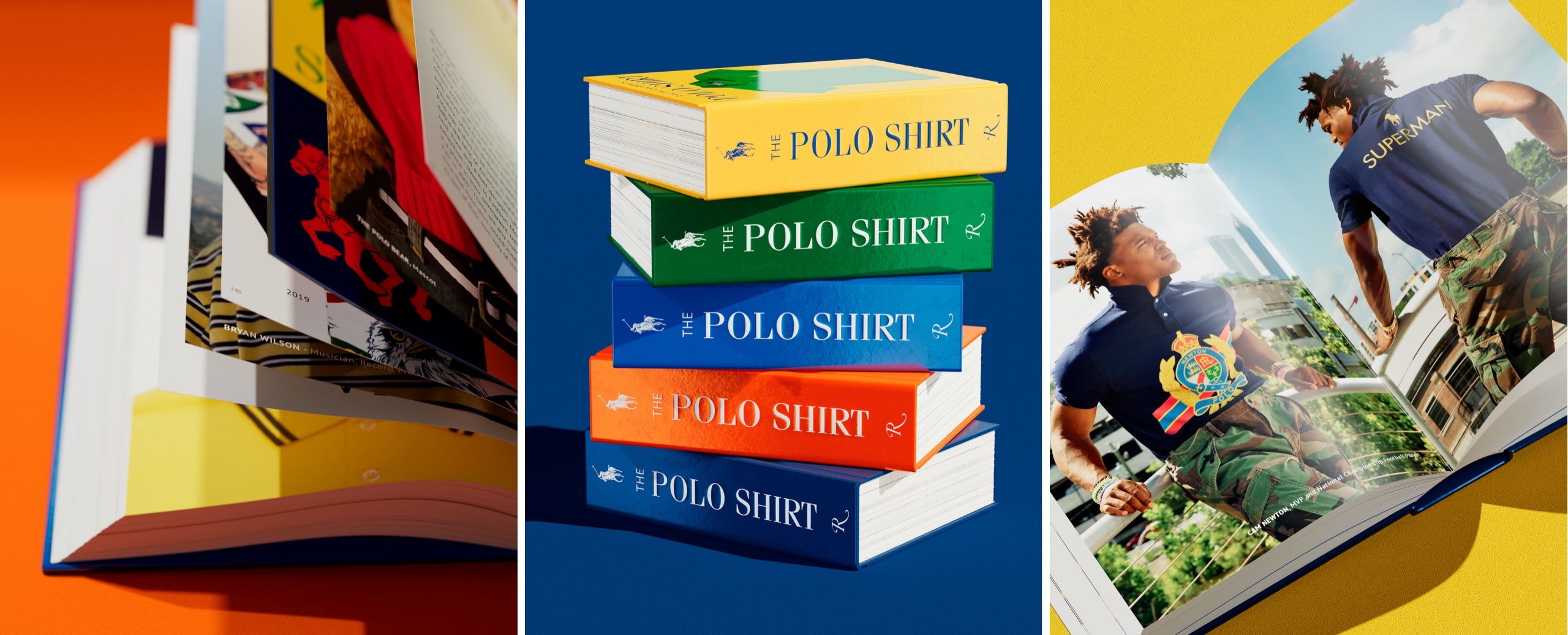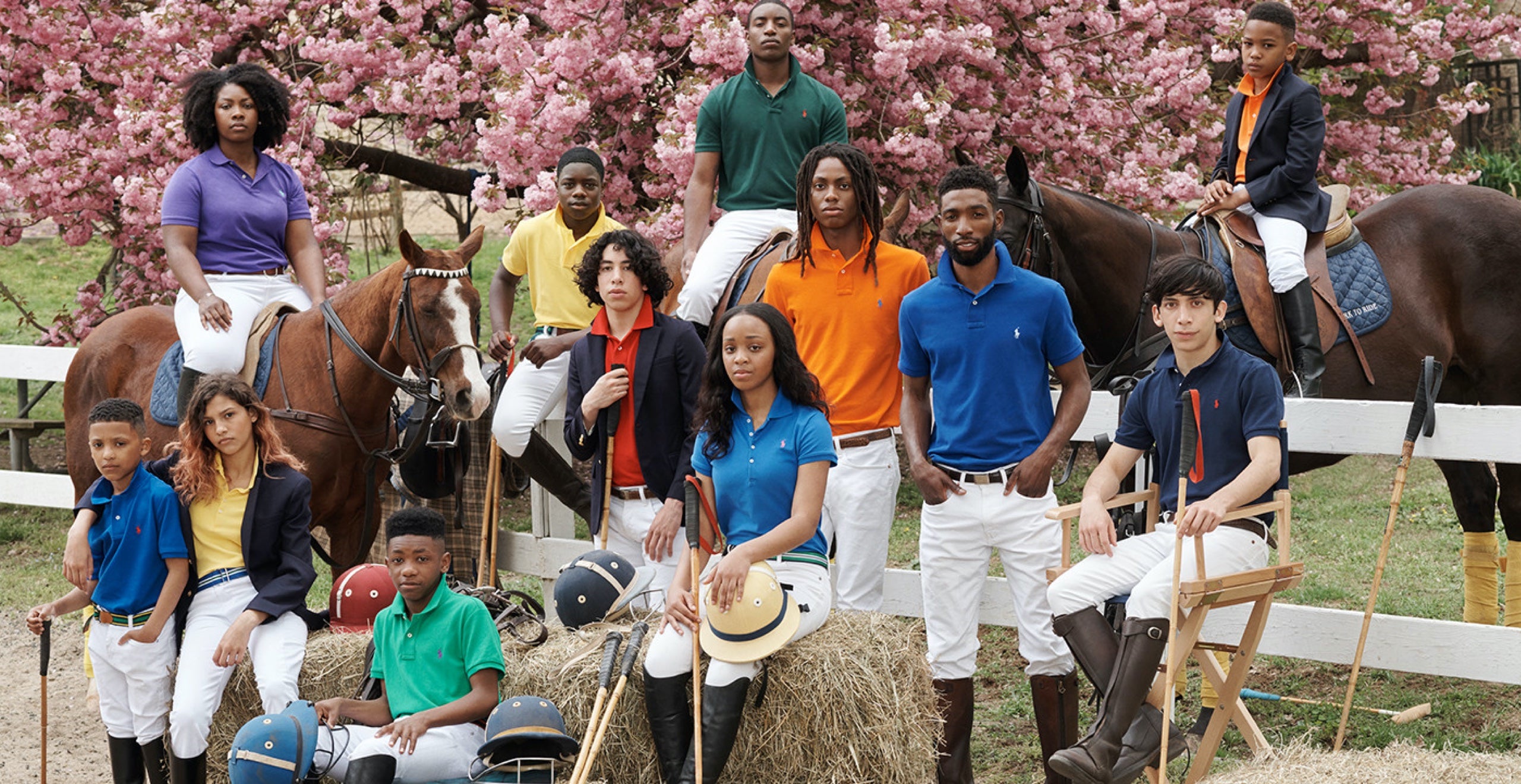
In the new book Ralph Lauren’s Polo Shirt, out now from Rizzoli, Ken Burns writes that when Ralph Lauren designs, he engages with timelessness. “We all get too identified with the material, the thing,” he writes. “But it’s not that, it’s that elusive ‘something’ that emanates from it.”
Maybe that’s why it’s hard to believe the Polo shirt is 50 years old. It feels, in some ways, like it was always with us—timeless. And yet, were you to pick one up today, you might also remark at how fresh it still feels. To understand this elusive “something” it helps to consider the shirt’s full journey: where it’s been, where it’s going, and how it all began.
Let’s start with its namesake: Polo. In the mid-19th century, players in India, where the sport originated, began wearing a long-sleeve shirt with a collar that buttoned down, the better to stay put while astride one’s horse. British colonists admired the style, and brought it home to England, where it became popular. And while that silhouette lives on today, it’s not quite what we consider a Polo shirt.
Instead, that style owes its origins to, ironically enough, the sport of tennis. In 1926, René Lacoste designed his own short-sleeve, collared, cotton piqué shirt and wore it at the US Open. One year later, in homage to his nickname, he added a crocodile to the chest. After he retired in 1933, he started making and selling his shirt to fans; over the coming decades, notable figures including presidents (Eisenhower, JFK), Hollywood legends (Bing Crosby, Bob Hope), athletes (Arnold Palmer), and regal style icons (The Duke of Windsor) were all seen sporting a Polo shirt. At the same time, the style (increasingly made from that era’s new high-tech fabric: polyester) began catching on at Ivy League campuses, becoming a preppy statement.

Enter Ralph Lauren. In 1967, Polo debuted as a tie-making brand in New York City. By 1971, Ralph Lauren was designing clothes, and had introduced the now-iconic Pony insignia—not on a Polo shirt, but on the cuff of a women’s tailored shirt. The following year brought what would become a sartorial paradigm shift: the introduction of the Polo shirt in 1972. Made from interlock rather than cotton piqué (which breaks in better), with a flattering fit and an array of colors that has only expanded over time, it became an instant sensation (with fans including the likes of Frank Sinatra, who reportedly purchased 20 Polo shirts in one shopping trip).

And no wonder: The Polo shirt embodies the Ralph Lauren aesthetic. It’s sporty yet refined. It’s sophisticated enough to be paired with a navy blazer to the country club, while casual enough that Ronald Reagan could advertise his Western bona fides by wearing one to clear brush. The signature Pony—famously created using 1,100 stitches—is both aspirational and playful, an elegant design flourish layered with meaning. And then there’s the array of colors, which Mr. Lauren has identified as a key reason for the shirt’s success—there were 17 in 1977, and 66 more than 40 years later, each one chosen by the designer himself.

And color choices were just the beginning. Changing times brought ever-evolving iterations of the Polo shirt. During the ’80s, the brand began offering the style in stripes—Brooke Shields wore one on the cover of Vogue, next to the cover line “The American look at its best!” Polo also introduced a cleaner, sans serif interior label design, a shift that’s still helpful to the many collectors looking to identify the vintage of their latest find. In 1986, Polo offered the first alternative to the Pony: a crest. And in 1989, the connection to sport was made even more direct with the debut of Polo Golf, including a performance fabric Polo shirt with longer, looser sleeves. Tom Watson wore his at the Ryder Cup, the U.S. Open, and the British Open, further cementing the shirt’s iconic status.
Things loosened up in the ’90s with the first alteration to the Polo shirt’s basic shape: The Big Fit in 1991 was longer, looser, and (for men) included a chest pocket, all anticipating the decade’s emphasis on a more relaxed silhouette. In 1994, the pendulum swung the other way, as the Mini Polo for women debuted during a runway show, offering a trimmer fit and a shorter length that is still available today. And what would the ’90s have been without the Polo Bear? Everyone’s favorite fashion icon popped up on the Polo shirt not long after debuting in the 1991–1992 Holiday collection.
The ’90s also marked Polo’s first dip of the toe into international waters—literally, with the 1992 America’s Cup Polo shirt, bearing the American flag and team name. This was the beginning of a long relationship between the Polo shirt and some of the world’s biggest sporting events. In 2005, the ballpersons at the US Open tennis tournament began wearing Polo shirts, emblazoned with a larger pony, per Mr. Lauren’s direction, that would be more easily identified by fans watching a match on TV. One year later, the ballpersons at Wimbledon began wearing Polo shirts as well. And in 2008, the Polo shirt appeared on global sporting’s biggest stage, when Team USA donned a Polo shirt at the Closing Ceremony of the Olympic Games in Beijing. As the official outfitter of Team USA, Polo Ralph Lauren has dressed athletes for all the Olympic Games since—including, memorably, 2016, when a special shirt was used to identify medalists, whose Ponies were knit in gold, silver, or bronze.
The new century also brought some of the most meaningful Polo shirt variations. In 2003 customers were invited to play designer via the Create Your Own campaign, which also included a new Custom Fit—a midway point between the Classic and the Slim Fit. (By 2021, customization went all the way with the launch of Made to Order Polo shirts.) As part of the Pink Pony collection, created to raise money to fight cancer, a limited-edition run of Polo shirts—with, fittingly, a pink Pony—premiered in 2000. The Earth Polo, crafted with an innovative fabric made entirely from recycled plastic bottles, came out in 2019, the same year as the first Polo Pride shirt. (The rainbow-collared shirt was preceded by a rainbow Pride Pony.) One year later, with the world shut down due to the COVID-19 pandemic, The Polo Project: Design for Good competition helped raise money for relief efforts through a unique design contest, won by Michelle Smith for her poignant submission “Just Let Me Breathe,” depicting her son in a mask with the word “HOPE” behind him.

After so many years, and so many iterations, it’s only natural that the shirt has received a lifetime achievement award of sorts, having been added to the Museum of Modern Art’s permanent collection after its inclusion in 2017’s Items: Is Fashion Modern? exhibit. This spring, the full story is being told with Rizzoli’s Ralph Lauren’s Polo Shirt. “I wanted the shirt to become part of the life of the person who wore it,” Mr. Lauren writes in the preface. “I never knew that after 50 years, it would become such a personal icon all over the world.”

- © Ralph Lauren Corporation






